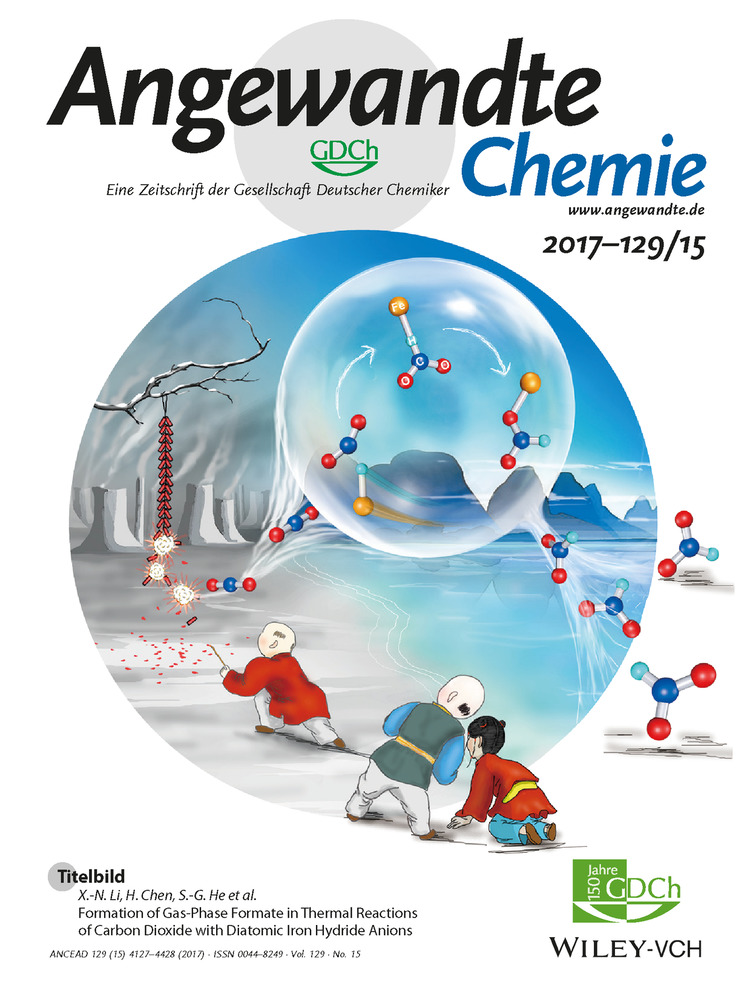Hydrophobic Water Probed Experimentally at the Gold Electrode/Aqueous Interface
Corresponding Author
Dr. Yujin Tong
Fritz Haber Institute of the Max Planck Society, 4–6 Faradayweg, Berlin, Germany
Search for more papers by this authorDr. François Lapointe
Fritz Haber Institute of the Max Planck Society, 4–6 Faradayweg, Berlin, Germany
Search for more papers by this authorDr. Martin Thämer
Fritz Haber Institute of the Max Planck Society, 4–6 Faradayweg, Berlin, Germany
Search for more papers by this authorProf. Dr. Martin Wolf
Fritz Haber Institute of the Max Planck Society, 4–6 Faradayweg, Berlin, Germany
Search for more papers by this authorCorresponding Author
Dr. R. Kramer Campen
Fritz Haber Institute of the Max Planck Society, 4–6 Faradayweg, Berlin, Germany
Search for more papers by this authorCorresponding Author
Dr. Yujin Tong
Fritz Haber Institute of the Max Planck Society, 4–6 Faradayweg, Berlin, Germany
Search for more papers by this authorDr. François Lapointe
Fritz Haber Institute of the Max Planck Society, 4–6 Faradayweg, Berlin, Germany
Search for more papers by this authorDr. Martin Thämer
Fritz Haber Institute of the Max Planck Society, 4–6 Faradayweg, Berlin, Germany
Search for more papers by this authorProf. Dr. Martin Wolf
Fritz Haber Institute of the Max Planck Society, 4–6 Faradayweg, Berlin, Germany
Search for more papers by this authorCorresponding Author
Dr. R. Kramer Campen
Fritz Haber Institute of the Max Planck Society, 4–6 Faradayweg, Berlin, Germany
Search for more papers by this authorAbstract
Quantitative description of reaction mechanisms in aqueous phase electrochemistry requires experimental characterization of local water structure at the electrode/aqueous interface and its evolution with changing potential. Gaining such insight experimentally under electrochemical conditions is a formidable task. The potential-dependent structure of a subpopulation of interfacial water with one OH group pointing towards a gold working electrode is characterized using interface specific vibrational spectroscopy in a thin film electrochemical cell. Such free-OH groups are the molecular level observable of an extended hydrophobic interface. This free-OH interacts only weakly with the Au surface at all potentials, has an orientational distribution that narrows approaching the potential of zero charge, and disappears on oxidation of the gold electrode.
Supporting Information
As a service to our authors and readers, this journal provides supporting information supplied by the authors. Such materials are peer reviewed and may be re-organized for online delivery, but are not copy-edited or typeset. Technical support issues arising from supporting information (other than missing files) should be addressed to the authors.
| Filename | Description |
|---|---|
| ange201612183-sup-0001-misc_information.pdf654.3 KB | Supplementary |
Please note: The publisher is not responsible for the content or functionality of any supporting information supplied by the authors. Any queries (other than missing content) should be directed to the corresponding author for the article.
References
- 1R. A. Marcus, Annu. Rev. Phys. Chem. 1964, 15, 155–196; R. R. Dogonadze, A. M. Kuznetsov, Prog. Surf. Sci. 1975, 6, 1–42.
- 2J.-J. Velasco-Velez, C. H. Wu, T. A. Pascal, L. F. Wan, J. Guo, D. Prendergast, M. Salmeron, Science 2014, 346, 831–834.
- 3A. Gross, F. Gossenberger, X. Lin, M. Naderian, S. Sakong, T. Roman, J. Electrochem. Soc. 2014, 161, E 3015–E3020.
- 4M. J. Kolb, R. G. Farber, J. Derouin, C. Badan, F. Calle-Vallejo, L. B. F. Juurlink, D. R. Killelea, M. T. M. Koper, Phys. Rev. Lett. 2016, 116, 136101; S. Maier, M. Salmeron, Acc. Chem. Res. 2015, 48, 2783–2790; J. Carrasco, A. Hodgson, A. Michaelides, Nat. Mater. 2012, 11, 667–674.
- 5J. O'M Bockris, A. K. N. Reddy, M. Gamboa-Aldeco, Modern Elelectrochemistry 2A: Fundamentals of Electrodics, 2nd ed., Kluwer Academic/ Plenum Publishers, 2000, chap. Six.
- 6K. J. Schweighofer, X. Xia, M. L. Berkowitz, Langmuir 1996, 12, 3747–3752.
- 7S. Izvekov, G. A. Voth, J. Chem. Phys. 2001, 115, 7196–7206; M. Otani, I. Hamada, O. Sugino, Y. Morikawa, Y. Okamotode, T. Ikeshoji, Phys. Chem. Chem. Phys. 2008, 10, 3609–3612; S. Schnur, A. Gross, New J. Phys. 2009, 11, 125003.
- 8M. F. Toney, J. N. Howard, J. Richer, G. L. Borges, J. G. Gordon, O. R. Melroy, D. G. Wiesler, D. Yee, L. N. Sorensen, Nature 1994, 368, 444–446.
- 9K. Ataka, T. Yotsuyanagi, M. Osawa, J. Phys. Chem. 1996, 100, 10664–10672.
- 10P. L. Geissler, Annu. Rev. Phys. Chem. 2013, 64, 317–337.
- 11A. Michaelides, Appl. Phys. A 2006, 85, 415–425.
- 12Y. R. Shen, Nature 1989, 337, 519–525.
- 13E. H. G. Backus, N. Garcia-Araez, M. Bonn, H. J. Bakker, J. Phys. Chem. C 2012, 116, 23351–23361.
- 14A. Lagutchev, S. A. Hambir, D. D. Dlott, J. Phys. Chem. C 2007, 111, 13645–13647.
- 15I. V. Stiopkin, H. D. Jayathilake, C. Weeraman, A. V. Benderskii, J. Chem. Phys. 2010, 132, 234503.
- 16A. G. Lambert, P. B. Davies, D. J. Neivandt, Appl. Spectrosc. Rev. 2005, 40, 103–145.
- 17Y. Tong, A. Vila Verde, R. K. Campen, J. Phys. Chem. B 2013, 117, 11753–11764; Q. Du, E. Freysz, Y. R. Shen, Science 1994, 264, 826–828; L. F. Scatena, M. G. Brown, G. L. Richmond, Science 2001, 292, 908–912.
- 18D. Chandler, Nature 2005, 437, 640–647.
- 19T. Smith, J. Colloid Interface Sci. 1980, 75, 51–55.
- 20K. H. Kang, Langmuir 2002, 18, 10318–10322.
- 21L. D. Burke, P. F. Nugent, Gold Bull. 1997, 30, 43–53.
- 22U. W. Hamm, D. Kramer, R. S. Zhai, D. M. Kolb, J. Electroanal. Chem. 1996, 414, 85–89; A. Hamelin, J. Electroanal. Chem. 1995, 386, 1–10; S. Efrima, E. Gileadi, J. Electrochem. Soc. 1973, 120, 879–882.
- 23W.-T. Liu, Y. R. Shen, Proc. Natl. Acad. Sci. USA 2014, 111, 1293–1297.
Citing Literature
This is the
German version
of Angewandte Chemie.
Note for articles published since 1962:
Do not cite this version alone.
Take me to the International Edition version with citable page numbers, DOI, and citation export.
We apologize for the inconvenience.




